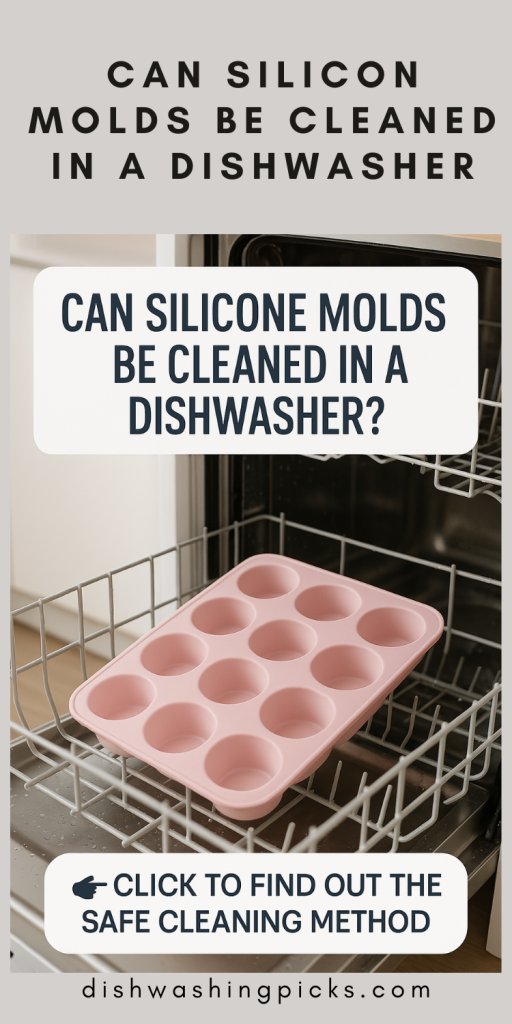So, you’ve just whipped up the cutest little chocolate hearts or some oddly satisfying homemade wax melts, and now you’re staring at the aftermath—your silicone mold, all gunked up and staring back at you like, “Yeah, good luck with this one.”
Cue the internal debate: Can I just toss this thing in the dishwasher and be done with it?
You wouldn’t be the first to ask. And honestly, I get it—life’s too short for endless handwashing, right?
First Things First: What’s Silicone, Anyway?
Before we even get to dishwashers, let’s hit pause and talk silicone for a sec. Silicone molds are super popular because they’re flexible, heat-resistant, non-stick, and (bonus!) they don’t rust or warp. Whether you’re baking cupcakes or crafting DIY soaps, silicone is the MVP of weird-shaped containers.
But here’s the real kicker: silicone isn’t just plastic. It’s actually made from silica (yes, like the stuff in sand), turned into a rubbery material through some fancy science. This means it can take a beating—heat, cold, squishing, stretching—you name it.
So now you might be thinking, “Okay, sounds like a tough cookie… so why wouldn’t it be dishwasher-safe?”
Great question. Let’s get into that.
The Straight Answer: Yes… But
Alright, here’s the deal:
Yes, most silicone molds are technically dishwasher-safe. Like, they won’t melt or fall apart or turn into a gooey mess. Most can handle temps up to 400°F+ (about 200°C if you’re fancy with metrics), so your dishwasher is a walk in the park.
But (and there’s always a but)—just because you can throw them in the dishwasher doesn’t always mean you should.
Why not? Well, that’s where things get a little more interesting.
Let’s imagine this: you toss your greasy, buttery mold into the top rack, slam the door shut, and go about your day. A couple hours later, you pull it out, expecting sparkling clean perfection. But instead… meh. There’s still a weird film on it. Maybe a greasy spot. Maybe a faint smell of garlic from last night’s lasagna (ew).
Yep, this happens. And here’s why 👇
We’ll pause here, and in the next session, we’ll talk about:
- Why dishwashers sometimes don’t clean silicone well
- The sneaky residue that sticks around
- And how to actually get your molds squeaky clean (with or without the dishwasher)
Why Your Silicone Molds Still Feel Greasy After the Dishwasher
Okay, so here’s the real talk: silicone has a superpower (or maybe a flaw, depending on how you look at it). It’s naturally non-stick, which is great for baking… but also means that it doesn’t always play nice with soap and water in the way we expect.
The problem?
Silicone is kinda like that friend who “absorbs the vibe” of any room they’re in. Except in this case, it absorbs grease, oils, and even odors like it’s on a mission. And once that happens, a standard dishwasher cycle might not cut it.
Ever noticed a weird filmy layer on your mold even after washing? Or worse, that faint whiff of yesterday’s curry clinging to your cupcake mold? That’s the residue we’re talking about. And it’s clingier than your ex on a Sunday morning.
Why the Dishwasher Might Not Do the Trick
Here’s what’s likely going down:
- Low water pressure: Dishwashers don’t scrub—if the gunk’s stuck, it stays stuck.
- Cooler cycles: Some dishwashers use eco-modes or cooler rinses that just don’t pack enough heat to break down the oils.
- Mold placement: If your silicone mold is flopping around the top rack or bunched in with other items, it might not be getting hit evenly with water and detergent.
So yeah, silicone might be dishwasher-safe by the book, but in practice? Sometimes it’s just… meh.
Now you’re probably wondering—so what’s the right way to clean them, then? Do I have to hand-wash every time?
Don’t worry, I got you. Let’s talk about the best ways to clean silicone molds next, with some life hacks that’ll save your sanity (and your sponge).
The Best Ways to Clean Silicone Molds (That Actually Work)
Alright, so the dishwasher didn’t quite do it. That greasy film is still there, and your mold smells like a weird combo of cupcakes and garlic bread. Not ideal.
But don’t worry—this isn’t one of those “you’ve been doing it wrong your whole life” rants. It’s more like, “here’s how to do it better, with less effort.”
1. The Good Old Soak-and-Scrub Method
Yeah, it’s basic. But also kind of underrated.
What you’ll need:
- Hot water (as hot as your hands can handle)
- A splash of dish soap (something degreasing, like Dawn)
- A soft sponge or a brush (bonus points if you’ve got a toothbrush for those little crevices)
What to do:
- Fill your sink or a big bowl with hot, soapy water.
- Let your mold chill in there for 15–30 minutes (enough time to scroll TikTok or make a snack).
- Give it a good scrub, especially in the corners. Silicone loves to trap stuff in those nooks.
2. The Baking Soda Boost
If your mold still feels slippery or smells funky—enter baking soda, stage left.
Just sprinkle some baking soda directly on the mold (focus on greasy spots), then scrub it in with a damp sponge. It acts like a gentle abrasive and deodorizer, without scratching anything.
You’ll be amazed at how much gunk comes off. Seriously. It’s like an exfoliation session for your bakeware.
3. Dishwasher (With a Twist)
If you still wanna use the dishwasher—and hey, who can blame you—here’s how to stack the odds in your favor:
- Place the mold on the top rack, spread out flat. No folding or cramming.
- Run the hottest cycle your dishwasher offers. Skip the eco mode this time.
- Use a grease-fighting pod or liquid detergent (avoid the super gentle ones).
- When it’s done, check for that residue. If it’s still there? A quick baking soda scrub will finish the job.
4. The Boiling Method (Extreme But Effective)
Alright, if nothing else works and you’re ready to go full MacGyver on your mold, try this:
- Boil a big pot of water.
- Drop the mold in (carefully—don’t burn your hands!).
- Let it simmer for 10–15 minutes.
This melts off stubborn oils and helps get rid of funky smells. Just don’t do this every week, or your mold might eventually lose some of its flexy magic.
How to Store Silicone Molds (Without Turning Them Into Dust Magnets or Weird Smell Absorbers)
Okay, quick question: have you ever pulled a silicone mold out of the cabinet only to find it smelling like the mysterious back corner of your pantry? Yeah. That’s because silicone is great at picking up and holding onto smells—especially when it’s just tossed in a drawer with, like, five rogue measuring cups and a stray rubber band.
Let’s not do that anymore.
1. Clean and Completely Dry Before Storing
Sounds obvious, but this is the number one rule people ignore (and then wonder why their mold smells like musty vanilla).
After washing, make sure your mold is 100% dry before you put it away. Even a little moisture can create a funky smell over time. Pat it dry with a towel, or better yet, let it air dry on a rack.
2. Store in a Sealed Container or Bag
This one’s a game-changer. Use:
- A large zip-top bag (bonus if it’s clear—you can see what’s in it)
- A plastic storage bin with a lid
- Even a repurposed cake carrier or baking tin
This keeps your molds from absorbing odors floating around your kitchen, like that onion you forgot in the fruit bowl (we’ve all been there).
3. Avoid Folding or Squishing Them
Silicone is bendy, sure. But that doesn’t mean it loves being jammed into weird shapes.
If you store your molds folded, they can eventually develop creases that mess with their shape—or worse, affect how your bakes come out.
Try storing them flat, or if they’re small, stack them neatly. Think of it like organizing your favorite records or video games—form and function.
4. Pop in a Little Baking Soda
Here’s a fun little hack: toss a tiny open container of baking soda (or one of those little fridge deodorizers) into the bin or drawer where you store your molds. It’ll absorb any weird smells before they make it into your silicone.
Bonus: you’ll feel weirdly organized and domestic, like a Pinterest mom who has her life together.
That’s a Wrap!
So, can silicone molds go in the dishwasher? Yes—but with a few caveats.
And now, you know how to clean them better, store them smarter, and keep them fresh and ready for action.
Whether you’re baking brownies or molding soap, your silicone tools are low-maintenance if you give them the TLC they deserve. Think of them like the chill roommate who only gets weird when you ignore them for too long.

